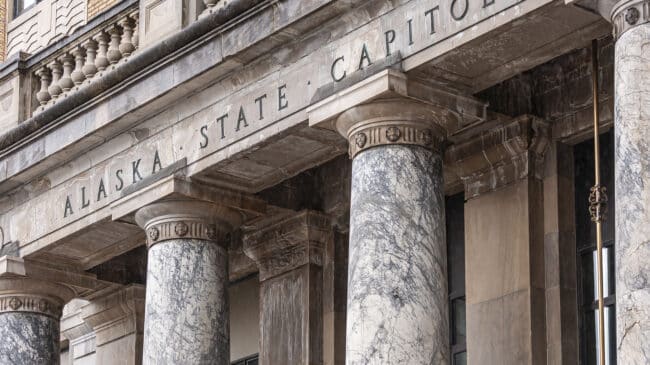A version of the following written comment was submitted to the Alaska House of Representatives Finance Committee on April 4, 2025.
Alaska House Bill 78 proposes reinstating a defined benefit (DB) pension plan for new public employees in Alaska. The stated goal is to improve recruitment and retention, but it is important to evaluate whether this change addresses the workforce challenges you face and whether it does so in a way that’s fiscally responsible and sustainable.
Our actuarial modeling shows that, under a best-case scenario, HB 78 would cost Alaska an additional $2.1 billion over the next 30 years. Under a more realistic scenario, if investment returns over the next 30 years resemble those Alaska has experienced over the past 23 years, the cost increases to $11.4 billion.
The outcome of this legislation is directly tied to investment assumptions. HB 78’s costs are based on an assumed rate of return of 7.25%, placing it among the top five highest assumptions in the nation. Yet Alaska’s pension funds have earned only 5.8% annually on average since 2001. That disconnect matters. If Alaska adopted a more realistic rate—say, 6.5%, which aligns with current actuarial best practices—current unfunded liabilities would immediately increase by $2 billion. Getting these assumptions right is critical. Otherwise, you risk creating a benefit structure that appears affordable on paper but proves unsustainable in practice. This body should be all too familiar with that practice, as you are still on the hook to pay $7.6 billion in unfunded pension liabilities to plans that have been closed for two decades.
Advocates of HB 78 often cite employee turnover as a rationale for moving back to a DB system. But the data doesn’t support the idea that Alaska is an outlier in this area—or that a DB plan would solve the problem.
According to our analysis of workforce data, Alaska actually retains public workers better than most states. In fact, from 2012 to 2023, Alaska had the 11th-lowest state employee turnover rate in the country, despite operating under a defined contribution (DC) system. During this period, Alaska’s average annual turnover rate was 13.6%, well below the national average of 18.7%.
Even in more recent years, when public sector workforce challenges have intensified nationwide, Alaska has remained relatively stable. From 2019 to 2022, turnover rose across all states, largely driven by pandemic-era labor disruptions. In Alaska, turnover reached a high of 17.5%, while the national average reached a high of 22.9%. This suggests that Alaska is experiencing the same labor market pressures as other states, not something unique to your retirement system’s design.
There’s also no clear evidence that states with DB plans perform better on recruitment or retention. Oklahoma, which transitioned to a DC plan in 2011, has not seen a rise in public employee turnover. In fact, it now has the second-lowest turnover rate among neighboring states, most of which still offer traditional pensions.
If recruitment and retention are unlikely to change from HB 78, who does this bill actually benefit? Because for most new employees in Alaska, HB 78 won’t actually improve retirement outcomes. Based on our modeling of Alaska’s benefit structure, more than 90% of new hires would receive lower retirement benefits under the proposed DB plan. That’s because most employees don’t stay long enough to benefit from a back-loaded DB formula. According to the pension system’s own assumptions, 50% of public safety workers and 70% of teachers leave within 10 years. For these employees, the current DC plan provides better retirement value and portability. Yet this bill would completely eliminate this DC option.
So where is the real gap in Alaska’s retirement security? It’s not in the pension structure; it’s in coverage under the Supplemental Annuity Plan, or SBS. Alaska public employees don’t participate in Social Security. SBS was designed as a replacement, providing a second layer of retirement income funded equally by the employer and employee with the same contributions that otherwise would have gone into Social Security. Because SBS acts as a true retirement account, it provides substantially better benefits than is given to participants of Social Security.
However, teachers are not covered by SBS, leaving them with no Social Security and no SBS benefit in retirement. This is a significant shortfall. Our modeling shows that, for a full-career teacher, SBS would provide an additional $60,000 per year in retirement. This is 73% greater than Social Security would be for the same worker. Expanding SBS coverage would do more to enhance retirement security than shifting back to a DB system that helps only a small segment of long-tenured workers.
In summary, Alaska is not facing a unique retention crisis, nor does it lag behind other states. Your turnover rates are better than average, and your DC plan—when combined with SBS—is already delivering retirement benefits better than most other states. HB 78 would add significant financial risk without clear evidence of improved outcomes. A more productive approach would focus on expanding SBS coverage and strengthening your existing retirement framework.
Stay in Touch with Our Pension Experts
Reason Foundation’s Pension Integrity Project has helped policymakers in states like Arizona, Colorado, Michigan, and Montana implement substantive pension reforms. Our monthly newsletter highlights the latest actuarial analysis and policy insights from our team.

